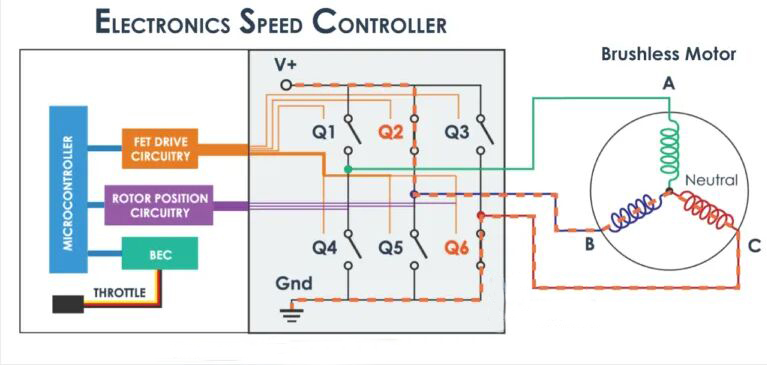How does an Electronic Speed Controller Work?
The electronic speed controller (ESC) is an essential part of an electric propulsion system's hardware. It acts like the brain of the system by telling the motor how fast to go based on data signals it receives from the throttle controller. For smaller applications like drones and RC vehicles, this controller has the name 'ESC', whereas for larger manufacturing applications it may be called an electronic control unit, inverter, or motor controller.
How does an Electronic Speed Controller (ESC) Work?
ESC has a "current control" role, ESC internal circuit has a set of MOSFET ("power tube"). Current input electronic speed controller, the internal circuit receives the signal from the receiver, according to the signal, the current makes the appropriate "control", and then the "control" of the current output to the motor, so as to control the motor start-stop and speed. As for the control part, the control signal controls the number of times the ESC is switched on and off in a unit of time. For different motors, it can be divided into brush ESC and brushless ESC; brush ESC is a simple DC output; brushless ESC is to convert DC into 3-phase AC power. ESC input is DC, which can be connected to a regulated power supply, or lithium batteries.

Electronic Speed Controller for Electric Vehicle
ESC plays a key role in automobiles by preventing a car from skidding & the vehicle driver from losing his control while driving a vehicle. This technology automatically activates the brakes to help steer the vehicle in the right direction.
It is one of the main active safety systems that are already connected to cars as well as commercial vehicles. In a European country, a maximum number of cars are available with ESC technology. Technology like active safety can prevent disasters from occurring altogether otherwise actively assists the driver to decrease the impact of a crisis. These systems provide the driver extra control in dangerous situations. So, different safety systems frequently monitor the vehicle's performance & its surroundings.

Electronic Speed Controller for Drone
In most applications of drones, the spread is constantly rising in a different range of applications which ranges from hobbyist to industrial and commercial & to most superior military applications.
The main benefits of Drones are, they can be operated remotely, so flying over regions is very difficult, inconvenient, or dangerous to attain in person. The commercial applications of drones are many like monitoring buildings, plants, agriculture, shooting areas & delivery of medicines, packages otherwise essential goods.
Generally, the high-range of drones is mainly equipped with BLDC motors but these motors need cautious & continuous speed regulation for the relative direction of revolution. For that, the ESC circuit is responsible. So the ESC design mainly includes the following features.
- The topology is utilized for controlling the motor.
- Compromise between efficiency & cost.
- The kind of battery used on the drone.
- Necessary performance.
- EMC (electromagnetic compatibility) and resistance to interference.

